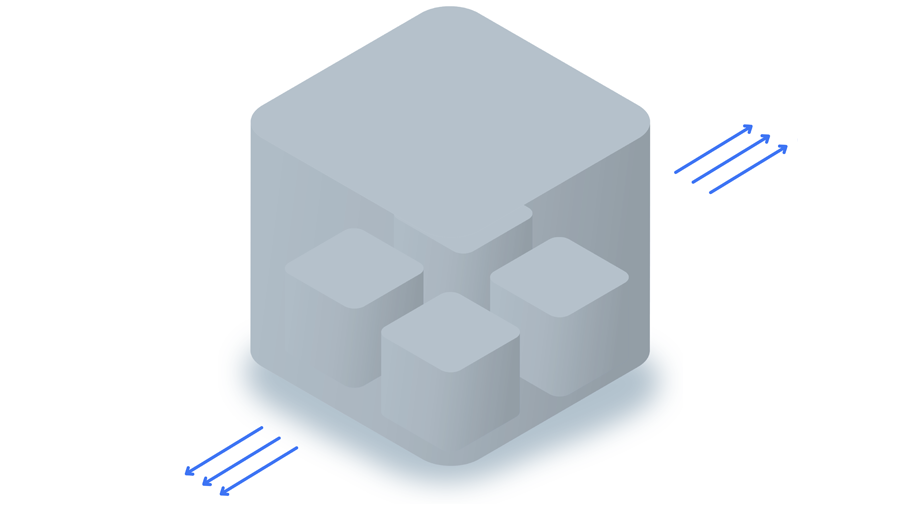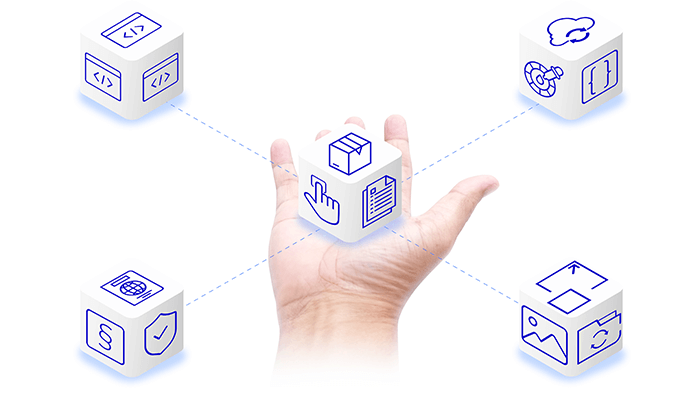The Only Guide to Composable Commerce You Need
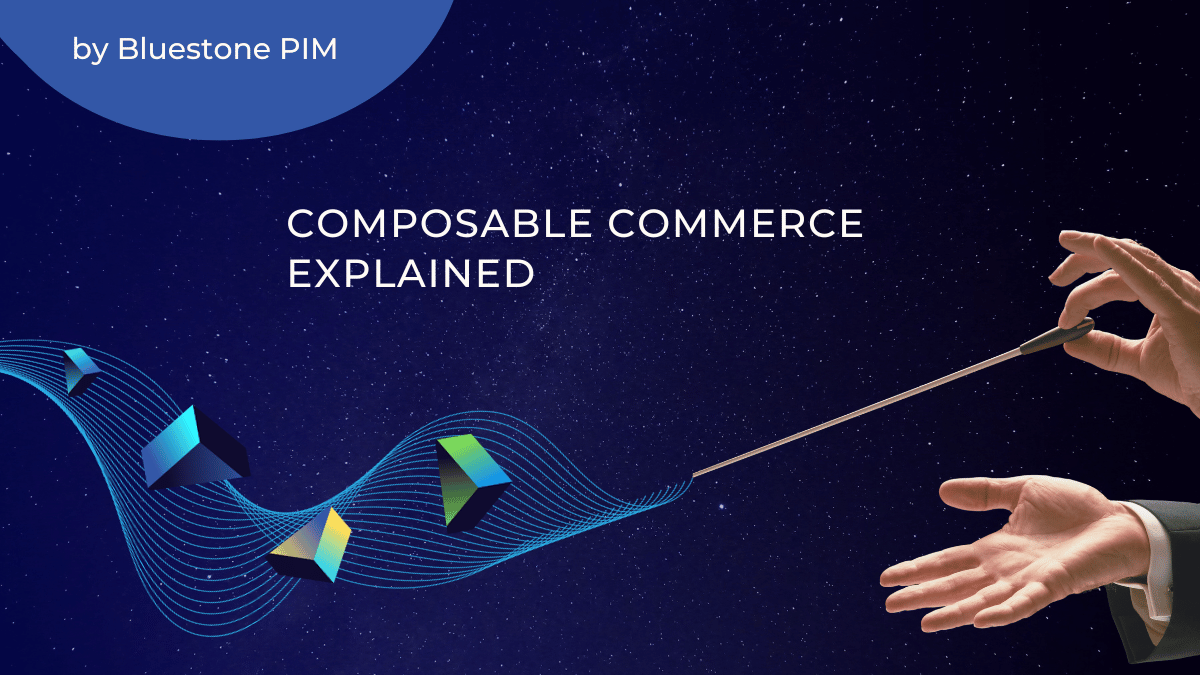
Table of Contents
- What is composable commerce?
- The tenets of composable commerce
- Traditional vs composable commerce
- Headless vs composable commerce
- Role of MACH architecture in composable commerce
- How does composable commerce work?
- Example of composable commerce workflow
- Benefits of composable commerce
- Drawbacks of composable commerce
- What to check when developing a composable enterprise?
- Does Bluestone PIM enable composable commerce?
- Summary
Composable commerce is going through the modern retail landscape like a storm.
Key findings from Elastic Path's March 2023 study, "The State of Merchandising," show that "72% of U.S. retailers are already using composable commerce in at least some manner, and another 21% are planning to adopt it within the next year."
So what is the phenomenon of this technology?
Here's a real-world example: let's say a retailer is preparing for increased traffic during the Black Friday / Cyber Monday peak periods. The company has a monolithic technology package based on solutions from a single vendor, a convenient "all-in-one" platform.
But time is running out, and efforts to improve the scalability of the eCommerce platform are progressing slowly as the on-site team has to make preparations and add hundreds of new items on a regular basis.
Imagine that this company is not tied to a single vendor and can adapt different technologies to its business processes. This would allow team to unlock scalability, test new features to improve the customer experience, and easily add new payment options without impacting the shopping experience.
That's just a glimpse of what composable commerce is all about.
What is Composable Commerce?
Composable commerce is a modular and business-centric approach that enables enterprises to customize their technology stacks by selecting best-in-class solutions to respond to complex business requirements.
Each solution can be assembled to meet a specific business need, defined as Packaged Business Capabilities (PBCs).
Composable Commerce and Packaged Business Capabilities
Packaged business capabilities (PBCs) are software components that serve defined business capabilities and can consist of a data schema, APIs, and a set of services. In practice, PBCs can be a shopping cart, a new channel, or a payment option in a form accessible to an end user. They are scalable and can be developed independently.
The use of PBCs fits perfectly with the composable architecture. With this powerful combination, business teams can participate in the design and delivery of new experiences, creating more user-friendly business solutions.
The Tenets of Composable Commerce
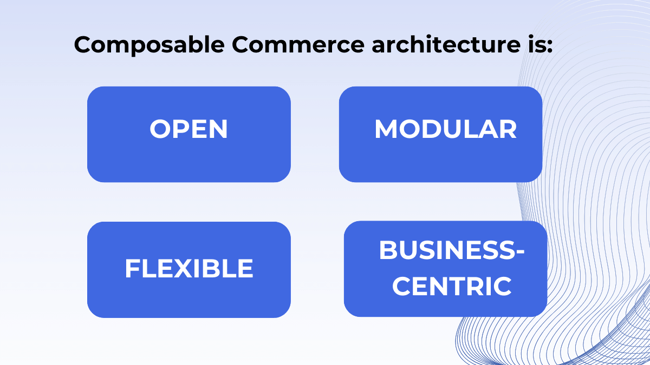
Composable commerce is based on four fundamental principles:
Modularity: Solutions are not tightly coupled, can be deployed independently, and are interchangeable over time.
Openness: Composable commerce operates within an open ecosystem. The solutions can be easily customized and integrated with other IT components.
Agility: Companies can be more agile and adapt quickly to changing markets and accelerate time-to-market, for example, by adding new features or channels to their modern technology stacks.
Business-centricity: With a composable architecture, companies have more opportunities for business innovation and rapid deployments at lower costs.
Traditional vs Composable Commerce
Composable commerce architecture based on independent modules is an alternative to the traditional digital commerce platforms based on a monolithic architecture, where different components are combined into a single unit.
Monolithic platforms can be a convenient solution as an enterprise has everything in one place, and from one vendor.
On the other hand, this technology approach has complex scalability and a slower pace of development. When a new feature implementation or any change needs to be made in a code base, developers need to update the entire system, not just a specific part.
Headless vs Composable Commerce
Headless commerce refers to the decoupling of the front-end presentation layer (the layer customers interact with when visiting the online store) from the back-end engine (functionalities). These two layers operate independently of each other and communicate with each other via APIs (application programming interfaces).
The composable commerce architecture incorporates the headless commerce approach (back-end and front-end as decoupled layers) but goes a step further by enabling the separation of back-end services. Components can communicate with their entire environment (front-end and back-end elements).
This means that companies have full freedom to extend their commerce solutions and tailor the technology to their exact business needs.
%20(1)%20copy.png?width=650&height=366&name=composable-commerce-headless-mach%20(1200%20%C3%97%20675px)%20(1)%20copy.png)
Role of MACH Architecture in Composable Commerce
As with headless commerce, MACH also has a strong link with composable commerce.
MACH is a technical architecture for building systems and software based on the blend of four technologies – Microservices, API-first, Cloud-native, and Headless. Together, this combination provides enterprises with greater flexibility in software development.
The MACH architecture is how the technology stack delivers Packaged Business Capabilities with respect to the composable commerce approach. MACH architecture facilitates the building of a composable commerce ecosystem with best-of-breed solutions.
In other words, as Kelly Goetsch, co-founder of the MACH Alliance, points out – “Composable is the 'what', MACH is the 'how.'”
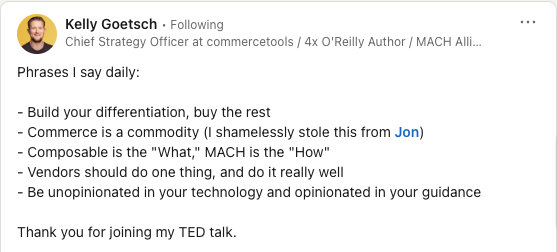
How Does Composable Commerce Work?
A composable commerce ecosystem is similar to a structure made of Lego bricks.
Each brick represents a specific component, and just like Lego, you can mix and match these components to create a unique and customizable eCommerce solution.
Together, these building blocks create a robust and adaptable eCommerce ecosystem that meets your specific business needs.
To get to know this technology well, it pays to know the different types of components and how they can be connected.
Microservices
The eCommerce platform is divided into smaller, independent services called microservices. Each microservice takes care of a specific aspect of the eCommerce process, such as product catalog management, order processing, payment processing, and customer management.
The microservices-based approach facilitates the development, scaling, and maintenance of individual components.
Api-First Approach
APIs enable seamless communication and integration of different microservices.
An API-first approach means that the design and documentation of APIs is prioritized from the beginning, making it easier to connect and extend the system.
Composable Commerce Engine
This is the core component that manages the orchestration of the various microservices and ensures that they work together.
It handles tasks such as routing customer requests, managing session data, and merging data from different services.
Experience Layer
This part of the architecture is responsible for user interface design and customer experience.
It can include front-end technologies such as Content Management Systems (CMS), Headless CMS, Progressive Web Apps (PWAs), and front-end frameworks to create a customized and engaging user experience.
Commerce Services
These services include all eCommerce functions such as managing product catalogs, inventory, pricing, promotions, and order fulfillment.
Each of these services can be selected individually and integrated into the architecture as needed.
Payment and Checkout Service
A critical component of any eCommerce platform is the ability to securely process payments and facilitate the checkout process.
Composable commerce companies choose and integrate the payment gateways and checkout solutions that best meet their needs.
Analytics and Personalization
Leveraging data analytics and personalization tools is essential to understanding customer behavior and customizing the shopping experience.
These components can be integrated to gather insights and provide personalized product recommendations, content and marketing.
Third-Party Integrations
Composable commerce platforms often support integration with various third-party services, such as customer relationship management (CRM) systems, marketing automation tools, shipping and fulfillment services, and more, to improve overall functionality.
Scalability and Cloud Infrastructure
To meet growing business needs, composable commerce relies on cloud infrastructure and scalable hosting solutions.
This allows businesses to scale their platform up or down depending on traffic and demand. The true composable application is always cloud-native.
Security and Compliance
Robust security measures and compliance with data privacy laws are essential for any eCommerce platform.
Composable commerce architectures should include components to protect customer data, ensure payment security, and comply with data governance regulations.
DevOps and CI/CD
Continuous integration and continuous delivery (CI/CD) are essential to efficiently manage and deploy updates and changes to the eCommerce platform. DevOps practices and tools are used to automate these processes.
Monitoring
Components to monitor the performance and health of the eCommerce platform, as well as analytics tools to track user behavior and site performance, are essential to optimize the customer experience and make data-driven decisions.
Example of Composable Commerce Workflow
Remember: Packaged Business Capabilities (PBCs) are the capabilities and solutions (like PIM, CMS or search), while tech stack is the way these PBC blocks are built and brought together.
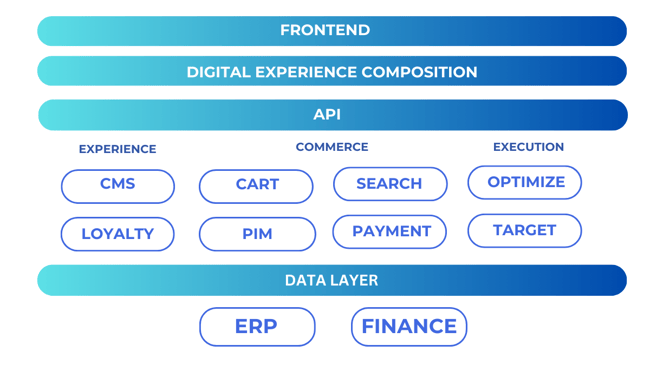
An example of a composable commerce stack
Let's put all the basic components together and see how a composable commerce solution works.
Here are some basic workflows:
Customer Experience from a Modular Perspective
With its modular approach, composable commerce allows companies to break down the customer journey into different components, making it easier to customize and optimize each element for a personalized shopping experience.
Customers benefit from smoother navigation, personalized recommendations, and an overall improved shopping experience.
Assembling Storefront Components
One of the cornerstones of composable commerce is the ability to assemble different storefront components.
These components include the product catalog, shopping cart, checkout process, and more. Companies can then select and integrate these modules according to their unique needs and objectives.
For example, a fashion retailer might prefer an engaging product catalog, while a digital service provider might focus on optimizing the checkout process. This flexibility allows companies to align their online presence with their specific goals.
Interaction Between Microservices
Behind the scenes, composable commerce relies on a network of microservices that manage various aspects of eCommerce operations. Payment processing, inventory management, and customer support are just a few examples.
These microservices communicate and work together seamlessly to ensure a frictionless shopping experience.
Managing Data
What customers see is the user experience layer. But as John Williams, thought leader and creator of Going Headless with Jon channel, points out in his video, composable commerce is not only about the UX, but also about a specific approach to orchestrating data.
For example, communication between the PIM system, the central repository for product data, and the content management system (CMS) is carried out via API. When changes occur, the composable platform updates various information in real time, ensuring consistency across all channels.
Benefits of Composable Commerce
Composable commerce tightly integrates the capabilities of modern technologies with business logic.
This takes companies to the next level and helps them meet demanding customer expectations and the challenges of the rapidly changing digital commerce marketplace in the following ways:
Benefits for the Entire Enterprise
Business Management
With the power of composable commerce, business leaders can make the enterprise eCommerce stack more flexible, scalable and competitive.
With this approach, technology can adapt to your business strategy, not the other way around.
IT Management
Composable commerce means saying goodbye to vendor lock-in.
By implementing this technology, companies can choose any software and create customized best-of-breed solutions.
Marketing and Sales Teams
In practice, composable tools enable easier and faster creation of exciting customer experiences by maximizing data synchronization and connecting more efficiently with sales channels.
Technical Advantages
Flexibility in Building a Technology Stack
With composable commerce, companies can choose the best tools and services for each specific function, such as content management, order processing, payment gateways and more.
This flexibility enables companies to adapt and scale their technology stack as their needs evolve without having to completely overhaul their system.
Avoid Vendor Lock-in
One of the biggest concerns with traditional eCommerce platforms is the risk of vendor lock-in.
If you rely on a single vendor for all your needs, you become dependent on their proprietary technologies, which can make it difficult to migrate or integrate new solutions in the future. Composable commerce eliminates this risk by allowing companies to select components from multiple vendors and swap them out as needed.
This is a great example of a big difference between composable and traditional monolithic commerce.
Faster Scalability
With composable commerce's flexibility to add or replace components in your tech stack, scaling becomes a seamless process.
Whether you need to handle increased website traffic, expand into new markets, or introduce innovative features, composable commerce enables you to scale your technology infrastructure without major disruptions or costly reconfigurations.
Freedom to Customize Your Platform
Composable commerce empowers businesses to customize their solutions to meet their business needs.
Whether it's creating a personalized customer experience, implementing complex workflows, or integrating legacy systems, the modular nature of composable commerce allows for tailored solutions that can drive efficiency and innovation.
Example💡 : Starboard, a well-known water sports brand, uses a composable Product Information Management (PIM) solution and its headless capabilities to customize its commerce platform and make teamwork more efficient.
Download the case study below to learn more about how a composable best-of-breed tool helped transform the company's business.
Business Benefits
Seamless Customer Experience at Every Touchpoint
By assembling a customized technology stack, you can integrate best-of-breed solutions for content management, CRM, payment gateways, and more.
This holistic approach ensures that your customers enjoy a cohesive and consistent experience, from browsing your website to making a purchase to post-purchase interactions.
Respond Quickly to Changing Business Needs and Trends
Composable commerce equips your business with the agility to respond quickly to these changes.
By choosing modular components that can be easily swapped in and out, you can adapt your eCommerce ecosystem to align with shifting market dynamics. This flexibility allows you to stay ahead of the curve and cater to emerging customer demands.
Future-Proof Your Business and Commerce Stack
Traditional monolithic systems can quickly become obsolete and require costly and time-consuming upgrades. Composable commerce, on the other hand, allows you to adapt to new technologies and industry standards as they emerge.
This flexibility ensures that your business remains relevant and resilient in the face of technological advances and changing market dynamics.
Deliver Innovative Experiences for eCommerce Platforms
Whether you're experimenting with new payment methods, introducing augmented reality shopping experiences, or implementing AI-powered chatbots for customer support, the modular nature of composable commerce empowers you to explore and deploy innovative features that can set your eCommerce platform apart from the competition.
One example of a company that has successfully composable commerce is Siemens Healthineers, a global medical technology company that has expanded its eCommerce capabilities for medical devices and healthcare solutions.
By implementing a modular architecture, the company was able to offer more efficient purchasing processes, a consistent patient experience, and improved customer support.
Drawbacks of Composable Commerce
Composable commerce is not all milk and honey. Like any innovative technology, it also brings challenges.
In the beginning, the freedom and flexibility can be overwhelming for internal development teams and they may struggle with the fear of the unknown.
Here are some challenges that companies adopting composable commerce might face:
Complex Integration Process
Integrating modular components seamlessly can be a complex and time-consuming process. Compatibility issues may arise, leading to unexpected technical challenges.
These challenges can manifest as data synchronization problems, communication breakdowns between components, and difficulties in maintaining consistent user experiences.
Dependence on IT Expertise
Building and maintaining a composable commerce stack often requires a high level of technical expertise. Companies must have a skilled IT team or access to experienced developers.
These challenges can take the form of data synchronization issues, communication breakdowns between components, and difficulty maintaining a consistent user experience.
Vendor Management
Managing relationships, contracts and service level agreements with a single vendor can be a demanding and time-consuming task, much like tending to a delicate garden.
However, when an organization is dealing with multiple vendors at once, it's like having an entire forest to maintain – a complex undertaking that requires you to work with even more people and demands even more effort and attention.
Lack of Comprehensive Support
In a composable environment, businesses may need to rely on support teams from multiple vendors.
Compared to a monolithic all-in-one architecture, the challenge of operating a composable commerce architecture may be assembling a technology stack with various best-of-breed components and working with multiple vendors.
Therefore, this "DIY approach" is recommended primarily for digitally mature and solution-oriented companies.
What to Check When Developing a Composable Enterprise?
If your company has already implemented MACH technology or headline solutions, you are on the right track to initiate a composable commerce strategy.
However, if you are feeling a little lost, here are two tips to help you get started in the right direction.
-
If you are still at the beginning of your journey, start with the cornerstone and turn to MACH architecture (for some tips, read our article Getting Started with MACH Architecture). Before you start, you need to prepare the entire organization for digital transformation, take care of support, and aim for close collaboration between business and IT departments.
-
Next, you need to map your development tools and API documentation to prepare for customization of the tech stack and compose it by adding best-of-breed components. Developing a composable enterprise is about testing capabilities. Digital transformation from monoliths to microservices can be done incrementally as you test and deploy platform by platform, system by system, and application by application.
Does Bluestone PIM Enable Composable Commerce?
Yes, we do! We are the first product information management software based on the principles of the MACH architecture and a proud member of the MACH Alliance.
Bluestone PIM can be successfully integrated into the composable technology stack alongside other best-of-breed solutions such as Headless Content Management Systems (CMS), Digital Assets Management (DAM), Enterprise Resource Planning (ERP) systems, or marketplaces.
To learn more about how MACH-based PIM works, how it can strengthen the eCommerce stack, and the benefits it brings to businesses, visit our Resources Hub.
Summary
Given the ever-changing tides in the eCommerce industry, composable commerce isn't an alternative anymore.
It is slowly becoming mainstream.
The composable approach offers companies the opportunity to become more agile and future-proof, from eCommerce platform development to omnichannel strategies to implementing new trends in digital marketing.
Have a question about composable commerce and how it can specifically help your business? Get in touch with our consultants and get your questions answered. Or schedule a demo meeting to see our composable PIM solution in action!



